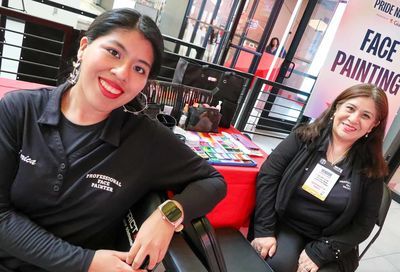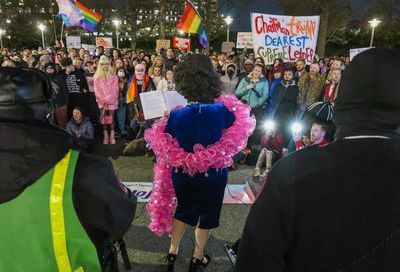Exploring the ‘Intense’ Work of Faith Ringgold
 “It’s really intense,” says Kathryn Wat of the National Museum of Women in the Arts (NMWA), referring to Die, a 1967 oil painting by Faith Ringgold (see above). You might even call that an understatement about an image featuring people of all ages, races and genders struggling through rampant violence and bloodshed — Ringgold’s reaction to the race riots of the 1960s. At least one woman fled a 1967 exhibition in New York the moment she saw the painting, according to Wat. And even after nearly five decades and countless examples of Hollywood-influenced violent imagery later, Die is still pretty shocking.
“It’s really intense,” says Kathryn Wat of the National Museum of Women in the Arts (NMWA), referring to Die, a 1967 oil painting by Faith Ringgold (see above). You might even call that an understatement about an image featuring people of all ages, races and genders struggling through rampant violence and bloodshed — Ringgold’s reaction to the race riots of the 1960s. At least one woman fled a 1967 exhibition in New York the moment she saw the painting, according to Wat. And even after nearly five decades and countless examples of Hollywood-influenced violent imagery later, Die is still pretty shocking.
Die was the only image Metro Weekly included from NMWA’s Ringgold exhibition American People, Black Light as part of the print magazine’s annual Museum Issue. I figured it’d be helpful to share Wat’s insights into the painting here, since that was missing from my profile of the oil paintings Ringgold made prior to her more famous work in the 1980s creating painted story quilts. Instead, I focused on Ringgold’s first public commission, For The Women’s House, which featured aspirational images of women and was painted for the female prisoners at Rikers Island in 1971 (at right). I also detailed Wat’s favorite painting, Ringgold’s 1965 Self-Portrait (see below).
A visitor can see how the African-American artist’s style evolved in the decade in which she made the 49 paintings in the exhibition, as her later works include more African-influenced design and achieves a broader spectrum of skin color than what she had learned in school. “When she was being trained as an artist, nobody could teach her how to paint skin that had color to it,” Wat says during a guided tour of the exhibition. “So color is at the core of what she’s interested in at this point, both figuratively and literally.”
But before she reached what Wat calls her “black is beautiful” Black Light series, Ringgold culminated her American People series, which documented and reacted to the racial tensions in ’60s America, with Die. The painting was in part a response to a conversation Ringgold had with African-American painter Hale Woodruff, who at the time was a neighbor of hers in Harlem. Wat says Woodruff complained to Ringgold that her works prior to Die “don’t seem to have much sense of rhythm. Everything’s kind of static in your work.”
Die is nothing if not static, with “its tremendous tangle of figures and limbs,” Wat explains. “Scholars have looked at this painting, and they look at how the women — you see white women and black women — seem to be trying to stop [the violence]. But there’s also a sense in all of this that nobody seems to be into this. They all seem to be reacting to this force that’s coming from outside. Everybody seems terrified, everybody seems frightened.”
Support Metro Weekly’s Journalism
These are challenging times for news organizations. And yet it’s crucial we stay active and provide vital resources and information to both our local readers and the world. So won’t you please take a moment and consider supporting Metro Weekly with a membership? For as little as $5 a month, you can help ensure Metro Weekly magazine and MetroWeekly.com remain free, viable resources as we provide the best, most diverse, culturally-resonant LGBTQ coverage in both the D.C. region and around the world. Memberships come with exclusive perks and discounts, your own personal digital delivery of each week’s magazine (and an archive), access to our Member's Lounge when it launches this fall, and exclusive members-only items like Metro Weekly Membership Mugs and Tote Bags! Check out all our membership levels here and please join us today!




















